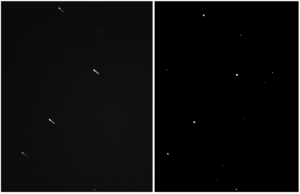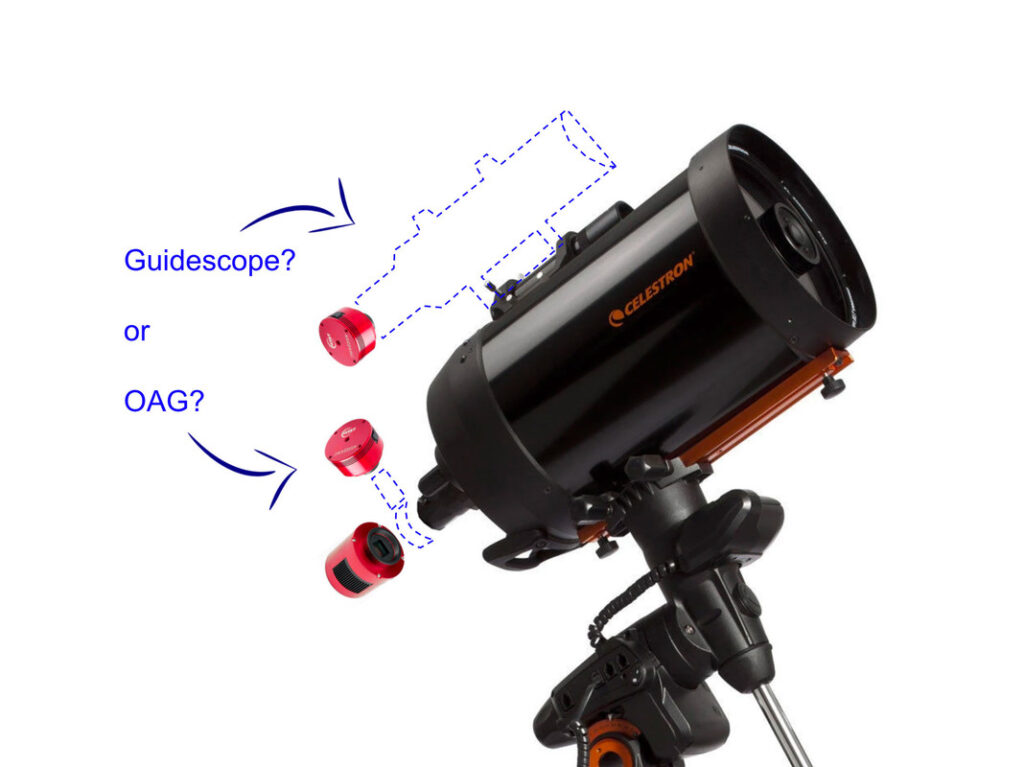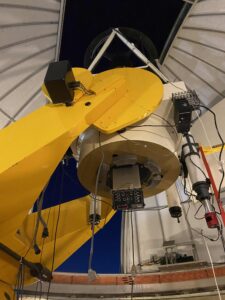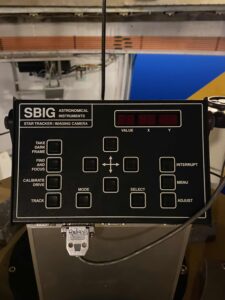Telescope Tracking
Although it may not look like it from minute to minute, the stars in the nighttime sky appear to move if you pay careful attention over an extended period of time. This isn’t due to the stars themselves moving through space (although they are in fact moving), but rather due to the Earth’s motion including both its rotation and–to a lesser extent–its orbit around the Sun.
This is a fascinating aspect of astronomy, but it causes some problems for anyone looking to see different objects over an extended period of time. This is because if the telescope being used is stationary over that time period, the image of the object in question will move out of view of the telescope. Furthermore in astrophotography, during any long exposure shots of more than thirty seconds or so, the objects in the image captured by the camera will appear to have trails behind them from the path they followed across the sky–this is called “trailing”.

To compensate for this, many telescopes are equipped with the ability to “track” objects in the nighttime sky. With this tracking system, the telescope will move at a fixed rate so that it seems to follow the same spot on the sky the entire time it’s being used. This fixed rate when observing stars and other deep-space objects is called the sidereal tracking rate.
Sidereal Tracking Rate
The sidereal tracking rate is the rate at which the stars appear to move through our nighttime sky and the rate at which a telescope must move to account for it and keep objects stable and in view. The rate we use on Earth is about 15.042 arcseconds per second. This rate is directly derived from the motion of the Earth. The Earth rotates around its axis at a rate of 360° per 24 hours, and the Earth orbits the Sun at approximately 1° per 24 hours. Adding these two together, the sidereal tracking rate is approximately 361° per 24 hours, or 15.042 arcseconds per second. An arcsecond is an angular measurement equivalent to 1/3600th of a degree; challenge yourself to convert 361° per 24 hours to arcseconds per second to confirm the rate for yourself!
The sidereal tracking rate does come with its limitations, however. The sidereal tracking rate is very useful for observing stars and other deep-space objects, but unusable for closer objects whose observed motion isn’t caused solely by the motion of the Earth. Such objects include the other planets in the Solar System, the Moon, and the Sun. Tracking can still be used for the Sun and the Moon, but they use solar and lunar tracking rates, respectively. For other objects in our Solar System, special tracking rates must be used and vary depending on the position of those objects relative to the Earth.
Tracking is also prone to some error, which will become more apparent as the exposure time increases or if a higher magnification on the telescope is used. This error is far less of an issue when using auto-guiding as the telescope reacts to the small differences in the star’s position.
Telescope Guiding
Auto-guiding is a method similar to tracking in that it is used for following objects as they appear to move through the nighttime sky. While tracking, the telescope moves at a constant rate. However, while auto-guiding, the telescope moves based on data it receives. This data describes the star’s position relative to the telescope, and it comes from an external camera and computer.
Auto-guiding often requires more equipment than tracking, as many telescopes these days have tracking capabilities built into them. Auto-guiding requires not only the telescope, but also a camera and some kind of computer that can run auto-guiding software. Many different software programs exist for just this purpose, such as PHD2, an up-to-date open source clone of a now outdated software called PHD.
It is important to note that the camera being used for guiding must be a separate camera from anything being used for astrophotography. The guide camera will be continuously taking images while it is being used, which would conflict with a camera taking long exposure shots, therefore if the goal is to do both at the same time, there must be a different camera for each purpose.

This guide camera can be attached to a guidescope or to an off-axis guider (OAG) attachment. The guidescope setup requires a separate, smaller telescope for this guide camera to be attached. The OAG setup requires a special attachment that collects unfocused light and redirects it to the guide camera before it reaches the main camera or lens. The best choice for auto-guider setup depends on the type of telescope.
The general algorithm for most auto-guiding software is a fairly simple process. After setting up the camera and the software to communicate with each other and with the telescope, the user selects a star that they want the telescope to follow–i.e., the “guide star”. The software will keep track of the guide star’s position in the view of the camera. When the software detects any deviation in this position, it will send commands to the telescope motors to move in the proper direction in order to keep the guide star in the original position– and therefore keep the image stable.
Our Original Auto-Guiding System


The UMBC Observatory originally used an SBIG ST-4 CPU paired with an OAG attached CCD camera to auto-guide with the telescope. The system doesn’t use any external software, and the guide star is selected via controls on the front panel of the ST-4. The CCD detector consists of an array of 192×165 pixels. Photons come into the camera and are converted into photo-electrons when they hit the detector, producing a signal in the pixel it hits. In this way, a set of neighboring pixels with high signals may indicate a star. At the beginning of guiding, the user will select such a star to be used as a guide star by the CPU.
Between multiple exposures, the guide star may appear to drift. In these cases, the CPU will calculate how far it has drifted, and send commands to the telescope motors to keep the star in the original position. Our original auto-guiding system allows for a range of user-selected exposure times from 0.1s to 20s. This allows for stars with different brightnesses to be followed without using additional filters. The default exposure time is 1s.
Modernization Project
Oftentimes, the UMBC Observatory will be focusing on objects that are so dim that they require 600s or more (10 minutes or more) of exposure time. As discussed above, proper tracking and auto-guiding is important to keep such long exposures stable. For all objects, we intend to use the appropriate tracking rate along with auto-guiding to ensure that the resulting image is not trailing.
The ST-4 system is more than 20 years old, and there are now many modern alternatives. These alternatives are being explored in terms of their applicability to our system at the UMBC Observatory and their relative complexity to set-up and maintain.
Written 20230123 by Connor Kragh